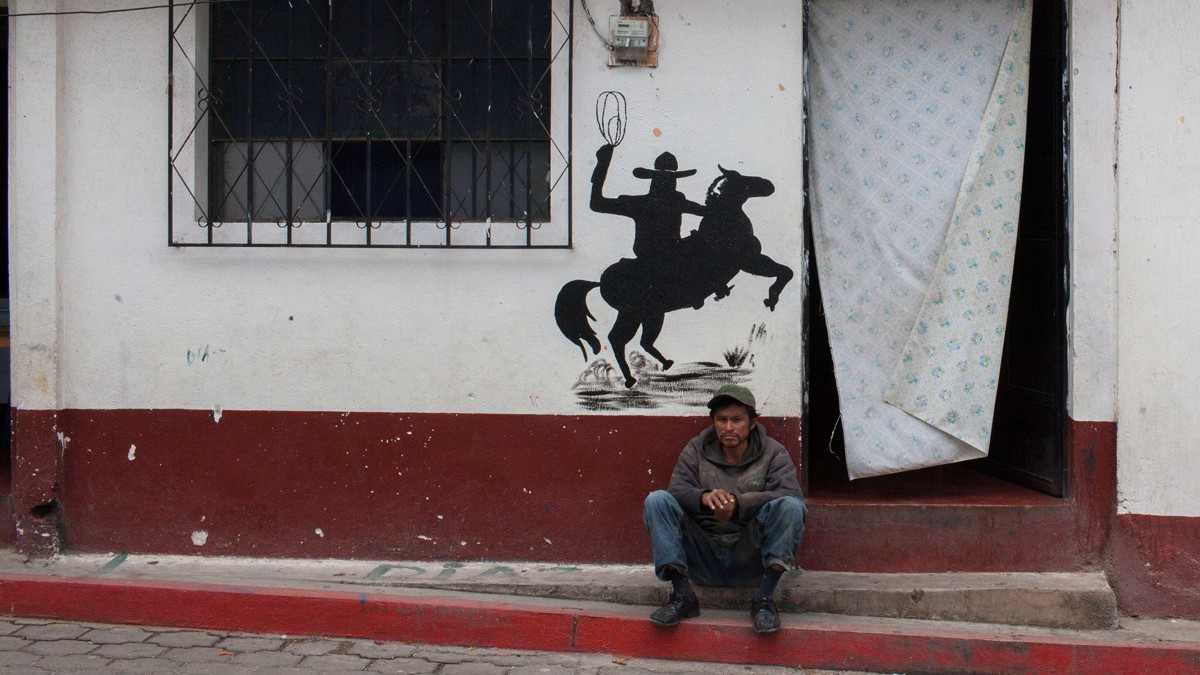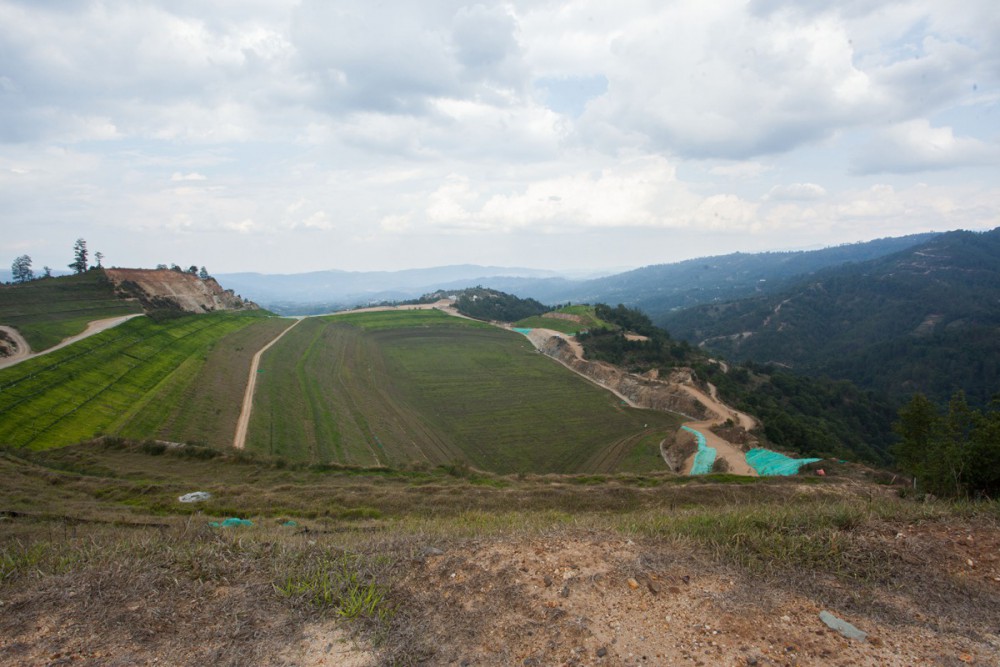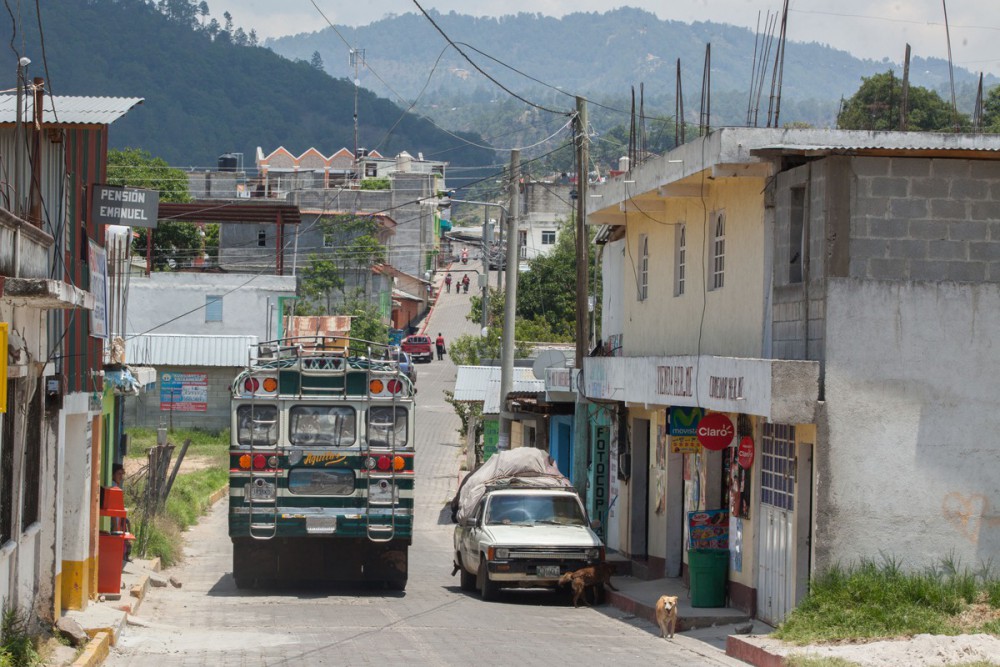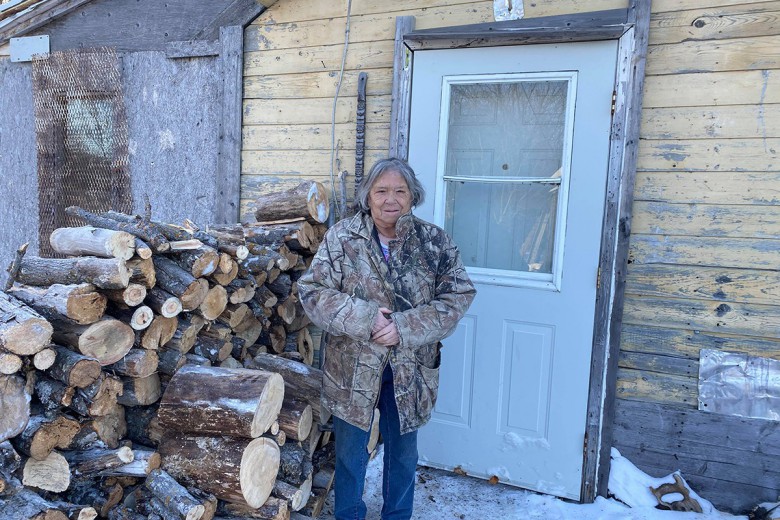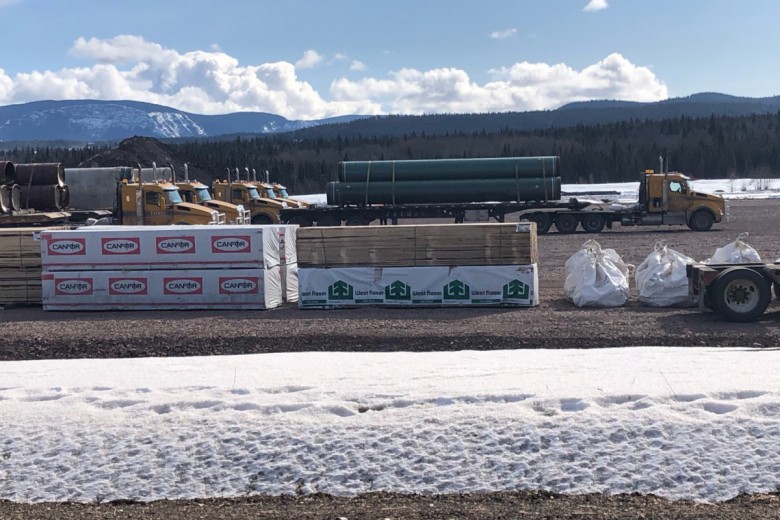A 20-minute drive from the centre of San Miguel Ixtahuacán, in the western highlands of Guatemala, sits an open wound.
Giant holes scar the earth where two open-air mines, owned by the Canadian company Goldcorp, lay. What we can’t see is some additional 147 kilometres of tunnels snaking beneath the ground. In the distance is the processing plant, where the company sifted through millions of tons of earth to extract the gold that lay under the Indigenous Maya Mam and Maya Sipakapense communities of the department of San Marcos.
Now, as the company is in the process of closing the mine, the plant remains a hub of activity.
“Twenty years ago, this was a mountain,” Humberto Velásquez, a Maya Mam resident of San Miguel Ixtahuacán and member of the resistance to the Marlin mine, tells me as we stand over one of the pits. The pieces of construction equipment down below look like tiny toys. Nearby, a truck from the Guatemalan National Police sits empty as four officers stand in the brush on the other side of the road.
Velásquez comments, “It is amazing, even after the mine closes, the police are still protecting the company.”
In February 2017, Goldcorp announced that the company was closing the controversial Marlin mine – Guatemala’s first large-scale gold mine – after 12 years of production. In the month following the announcement, residents of San Miguel Ixtahuacán blocked the entrance to the mine with tires, rocks, and their own bodies, insisting on a dialogue with the company to address damages to their community – the environmental effects, houses damaged by explosions, and the health impacts caused by production at the site. According to members of the resistance like Velásquez, the protests escalated after three government-mediated meetings between protesters and the company between April and June 2017, in which Goldcorp refused to pay for damages.
“Our demand at the protest was that the [company] has to pay for everything they have left in our community,” says Velásquez as we drive around the community. “They have to pay for the impacts to the water, [our] health, and the tunnels they have left.”
Francisca Pascual is a 57-year-old Maya Mam resident who was born in the village of Ixcail, which sits in the municipality of San Miguel Ixtahuacán, and she is a member of the local resistance to the mine.
“We want to recuperate everything that we have lost,” she says. “Our ancestors left us this land. They left it to us to protect. But now, what will we leave our grandchildren? Our grandchildren are going to suffer.”
“Our ancestors left us this land. They left it to us to protect. But now, what will we leave our grandchildren? Our grandchildren are going to suffer.”
The conflict over the Marlin mine reflects the violence of Canadian mining operations across the world. Canadian mining firms are frequently the cause of intense social conflict over resource extraction – from the murders at Banro’s gold mines in the Congo to gang rapes by security personnel at Hudbay’s nickel mines in eastern Guatemala. It’s estimated that 75 per cent of the world’s mining and exploration companies are based in Canada.
Between profits and investments
Since Goldcorp acquired Glamis Gold and its Guatemalan subsidiary, Montana Exploradora, in 2006, the Marlin mine has been incredibly profitable for the company and its investors. Between 2006 and 2010, the highlands of western Guatemala generated over $594.3 million in profits from the exploitation of the Marlin site. As international gold prices rose, so too did Goldcorp’s earnings. In 2013 alone, the mine generated $447 million.
Goldcorp has maintained that they are dedicated to resolving the social conflicts in the area around the mine as part of their corporate social responsibility policy. According to the company, $130 million was invested in infrastructure projects across the region since the beginning of the mine’s operations – which included paving roads, providing communities with potable water, and building infrastructure at the mining site. But the latter is in service of the mine, not the local communities, and served as a point of contention when power lines were run across private lands.
“The only development that arrived stayed only with them,” notes Margarita Sebastian Castellan de Leon, a 32-year-old community leader and a current auxiliary mayor of the village Chilive, which sits to the west of the mine. “The company managed to pave some roads, improve some schools, what else? In my community, we have not had a potable water project until now.”
Castellan de Leon says that residents were largely left out of the conversation about how to allocate the funds.
Researchers and community members point out that even though 97 per cent of the mine’s 1,582 employees were Guatemalan residents, only a tiny fraction of Goldcorp’s money has trickled down to the community.
“The only development that arrived stayed only with them.”
“The mine is leaving practically nothing,” laments Julio González, an activist from the environmentalist collective Madre Selva. “If you look at the people who live around the mine, they have very little, and a profound social division.”
“[The Marlin mine] is generating significant economic benefits in the operating phase in the form of wages in highly impoverished, subsistence-based local communities,” write Lyuba Zarsky and Leonardo Stanley in a report for Tufts University. “However, local benefits are a tiny fraction of total mine revenues and earnings, the bulk of which flow overseas to the company and its shareholders.”
They conclude that the economic benefit will abruptly cease and all evidence of economic development will disappear once the mine closes because Goldcorp failed to invest the revenues in sustainable industry.
International experts also raise concerns that Goldcorp is not closing the mining site in compliance with industry standards. A report from 2011, prepared by international mining and engineering experts, noted that the reclamation bond of only $1 million that the company paid to the Guatemalan government was “trivial” in comparison to international standards. The document estimated that the actual cost of the reclamation would be $49 million. The report also flagged that since the reclamation plan has not been made public, it lacks oversight that would guarantee proper closure of the site and therefore poses the additional threat of environmental contamination.
“If you look at the people who live around the mine, they have very little, and a profound social division.”
Goldcorp has left a trail of contaminated water and land in the wake of their prior mine closures. In 2009, a year after Goldcorp closed their San Martín mine in Honduras, an independent review of that shutdown raised concerns about the threat of acidic runoff due to the secretive nature of the reclamation plan and the potential for improper closure of the site.
Those concerns proved true in 2011 when it was revealed that the Honduran government had been covering up widespread sickness in the communities around the old mine. Residents showed high levels of arsenic and lead in their blood and urine.
Back in Guatemala, the lack of transparency of Goldcorp’s plan for closing the Marlin mine raised red flags in the community. Many residents tell me that they do not believe that the mine is actually closing, or speculate that it might just be moving to another site.
Goldcorp has left a trail of contaminated water and land in the wake of their prior mine closures
“I’ve heard that they are going to close the mine, but I don’t know if they are going to close or continue working,” says Pascual.
Leaving a divided community
Goldcorp is also walking away from deep social divisions that they created in the once tight-knit Indigenous communities of San Miguel Ixtahuacán and surrounding areas. The mine has driven a wedge between supporters of the project and those who are concerned about the impacts of the mine.
“Little by little they divided the community, the churches, the municipality, and even the catechists [of the Catholic Church],” explains Pascual. “This is horrible for us.”
The mine has driven a wedge between supporters of the project and those who are concerned about the impacts of the mine.
These social divisions have turned deadly. In 2005, Álvaro Benigno Sanchez, a 23-year-old resident of the village Pie de la Cuesta, Sipacapa, was shot near his home by security guards of the mining site. Another attack occurred in 2009, when workers from the mine burned an anti-mining activist to death.
To dismantle the resistance movement, the government issued arrest warrants for activists protesting the mine, accusing them of sabotage. González points to the case of Gregoria Crisanta Perez, a community leader who faced arrest due to her refusal to permit electric lines to pass over her land. According to González, the criminalization of activists in San Miguel Ixtahuacán set the precedent for how the state responds to other social conflicts in Guatemala. The Public Prosecutor’s office has since routinely filed criminal charges against leaders of social movements – such as Rigoberto Juárez Mateo and Domingo Baltazar, two community leaders in Huehuetenango who were detained and charged with instigating criminal activity in 2015.
The mine has also disrupted the social organization of Indigenous communities, often eroding residents’ sense of collective responsibility to the community. This has especially affected the practice of communal work that is foundational to Indigenous communities across Guatemala.
The mine has also disrupted the social organization of Indigenous communities, often eroding residents’ sense of collective responsibility to the community.
“The company taught the people that when there was a project in the community, such as a school or community salon, that they would be paid [for their work],” says Velásquez as we drive to one of the villages near the mining site. “Before, people would provide their time and work together. Now the people think that they should be paid when we go to repair or clean a road.”
On the national level, critics of the mine point out that Goldcorp and the mining sector in general have perpetuated corruption, including embezzlement and bribery, in the Guatemalan political system. In 2016, the Guatemalan Public Prosecutor’s office issued an arrest warrant for Eduardo Villacorta, the former Goldcorp senior vice-president for Central and South America. Villacorta is accused of being one of the illicit financiers of the 2011 campaign of Guatemala’s former president, Pérez Molina, and his Partido Patriota (Patriotic Party, a conservative political party in Guatemala). The Partido Patriota was cancelled following the arrest and prosecution of Molina for overseeing a criminal network that stole millions from the Guatemalan government.
It’s because of such corruption, critics say, that the company has faced little regulation and oversight of the mining location.
Critics of the mine point out that Goldcorp and the mining sector in general have perpetuated corruption, including embezzlement and bribery, in the Guatemalan political system.
“The expansion of mining firms in the country is one of the pillars of corruption in Guatemala. This is one of the major impacts of the mining sector,” says González.San Miguel Ixtahuacán sits along the Cuilco River, which feeds into southern Mexico. The region was once known as Tejutla and is famous for being an abundant source of water. Yet the mining operation guzzled over 250,000 litres of water per hour – far greater than the amount a family will use in 20 years. Soon after, wells began to run dry across the region.
“At least 28 water sources have dried up,” explains Velásquez. “The families have no place to get water. They have no water to drink, or for their animals.”
At the height of production, Goldcorp was importing 200 tonnes of cyanide a month for gold processing. The Catholic Church and residents have long accused the mine of poorly managing waste at the mining site, threatening the surrounding communities with cyanide contamination in the water. According to the company, the cyanide facilities at the Marlin mine have been decommissioned following international standards and protocols.
“We heard that the company was going to bring development, but this is a bunch of lies, as we have never seen development,” says Pascual. “The development that the company has left is sickness.”
As frustration grew over the lack of access to water and rampant human rights abuses, the communities took the mine to the Inter-American Commission on Human Rights (IACHR). In 2010, the commission ordered the Guatemalan government to suspend the mine’s licence due to concerns of environmental contamination.
“The development that the company has left is sickness.”
In addition, the commission asked the Guatemalan government to decontaminate the water sources of the 18 beneficiary communities and to ensure their members access to water, as well as “to adopt any other necessary measures to guarantee the life and physical integrity of the members of the 18 aforementioned Maya communities.”
The next year, the IACHR would withdraw their orders for the closure of the mine following intense pressure from Goldcorp. In their revised decision, the IACHR ordered the Guatemalan state to further guarantee access to clean water. In response to these orders, Goldcorp began to construct potable water systems in several communities. The company and the Guatemalan government have also taken steps to monitor communities’ water.
Yet this has not calmed the concerns of residents. In 2012, a resident near the mining site took her animals to drink from the Cuilco River, and on the way home her animals began to vomit and eventually died. Six years later, the Pastoral Commission for Peace and Ecology (COPAE) issued a study of water quality to coincide with the closure of the mine. Their findings revealed high levels of toxic metals in the three rivers in the region, and stated that the water is not fit for human or animal consumption – or even irrigation – due to the levels of contamination.
Their findings revealed high levels of toxic metals in the three rivers in the region, and stated that the water is not fit for human or animal consumption – or even irrigation – due to the levels of contamination.
Today, residents look upon the rivers and other water sources with suspicion.
“Many people close to the mine have grown sick, in part because they avoid bathing due to the lack of confidence with the water,” says Castellan de Leon. “Why? Because the mine has led to the contamination of our water, and because the many springs have disappeared.”
Unfortunately, the businesses that have benefited most from the mining activities in San Miguel Ixtahuacán are apparent in the town centres. Cantinas, or small bars, dominate nearly every street, with names such as “Gift from God” and “The Miracle.” Velásquez estimates there are at least 128 cantinas that have opened across town since 2005. The rampant consumption of alcohol by workers has proven to be a frustration for the Maya Mam community.
“This is the type of development that the mine has brought,” Velásquez explains to me as we drive through town. “The mine workers cash their cheques and go and buy alcoholic drinks.”


